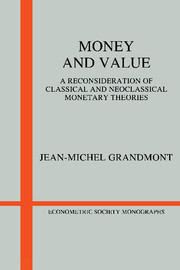1 - Expectations and the real balance effect
Published online by Cambridge University Press: 05 January 2013
Summary
This chapter will examine, with the help of a simple microeconomic model, two propositions that play a significant role in neoclassical monetary theory.
The first proposition is that “money does not matter” - or, more precisely, that if the mere presence of money as a medium of exchange and as an asset is important for the smooth functioning of the economy, the quantity of money is unimportant. This is the quantity theory tradition, which claims that a change in the money stock will change all nominal values in the same proportion, but will have no effect on “real” variables. This old tradition still plays an important role in modern thinking. We wish to clarify the exact meaning of this theory and its domain of validity.
The second issue will be the belief, which is shared by many theorists, that a short-run Walrasian equilibrium in which money has positive exchange value usually exists. We shall investigate this question by looking at a simple model involving only outside money. “Money” is then printed money, and can be regarded as a part of private net wealth. In such a context, neoclassical theorists assume that the traders' price expectations are “unit elastic,” so that expected prices vary proportionally with current prices. The essential short-run regulating mechanism is then the real balance effect. When money prices of goods are low, the purchasing power of the agents' initial money balances is large. This fact should generate, according to this viewpoint, an excess demand on the goods market at sufficiently low prices.
- Type
- Chapter
- Information
- Money and ValueA Reconsideration of Classical and Neoclassical Monetary Economics, pp. 8 - 47Publisher: Cambridge University PressPrint publication year: 1983



